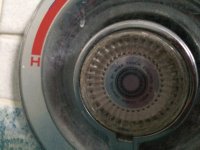Viktoria
New Member
- Messages
- 7
- Reaction score
- 1
- Points
- 3
I'm a first time poster, but a lurker for the last several months. I read a lot on this site before attempting to replace a hot water heater that was failing. I had enough time to really prepare, and I'm happy to say it went pretty well.
As to be expected, the very old galvanized hot line sprung a leak at a shutoff valve, about 24" from the heater, from the jarring/movement of the install. I knew it was very possible with such old pipes, and handled this too, by cutting the pipe and replacing. When installing the tank I was pretty impressed with how rusty and corroded the hot line was. The cold line was perfectly clear. When I cut the hot line the threaded end that fed into the shutoff valve was so disintegrated, it just fell out.
About a 4 or 5 days after the pipe repair, I went to take a shower and there was just barely a flow. I'm pretty convinced it's rust that was knocked lose from my work and is blocking the line. (Bathroom is second floor)
The bathroom sink however, has fine pressure. I assumed there must be powerful corrosion in the horizontal run between the sink and the tub.
The kitchen sink (first floor) is fed from a different branch off of the same trunk--pressure is fine.
So, now I am doing my research to prepare to replace the hot line to the tub. I'm spending a lot of time mapping the current system (one bathroom, one kitchen, small house).
I'm planning on cutting through the drywall in the bedroom behind the bathroom wall to do some more fact finding.
I was wondering if there is any possibility that the corrosion has lodged in the mixing bath/shower valve, and is restricting the flow? I don't know enough about the mechanics of the valve to know if this is likely, and thought I had better look into that possibility before I start cutting drywall.
The valve itself is new--I replaced it last summer.
Thank you for your input.
As to be expected, the very old galvanized hot line sprung a leak at a shutoff valve, about 24" from the heater, from the jarring/movement of the install. I knew it was very possible with such old pipes, and handled this too, by cutting the pipe and replacing. When installing the tank I was pretty impressed with how rusty and corroded the hot line was. The cold line was perfectly clear. When I cut the hot line the threaded end that fed into the shutoff valve was so disintegrated, it just fell out.
About a 4 or 5 days after the pipe repair, I went to take a shower and there was just barely a flow. I'm pretty convinced it's rust that was knocked lose from my work and is blocking the line. (Bathroom is second floor)
The bathroom sink however, has fine pressure. I assumed there must be powerful corrosion in the horizontal run between the sink and the tub.
The kitchen sink (first floor) is fed from a different branch off of the same trunk--pressure is fine.
So, now I am doing my research to prepare to replace the hot line to the tub. I'm spending a lot of time mapping the current system (one bathroom, one kitchen, small house).
I'm planning on cutting through the drywall in the bedroom behind the bathroom wall to do some more fact finding.
I was wondering if there is any possibility that the corrosion has lodged in the mixing bath/shower valve, and is restricting the flow? I don't know enough about the mechanics of the valve to know if this is likely, and thought I had better look into that possibility before I start cutting drywall.
The valve itself is new--I replaced it last summer.
Thank you for your input.

